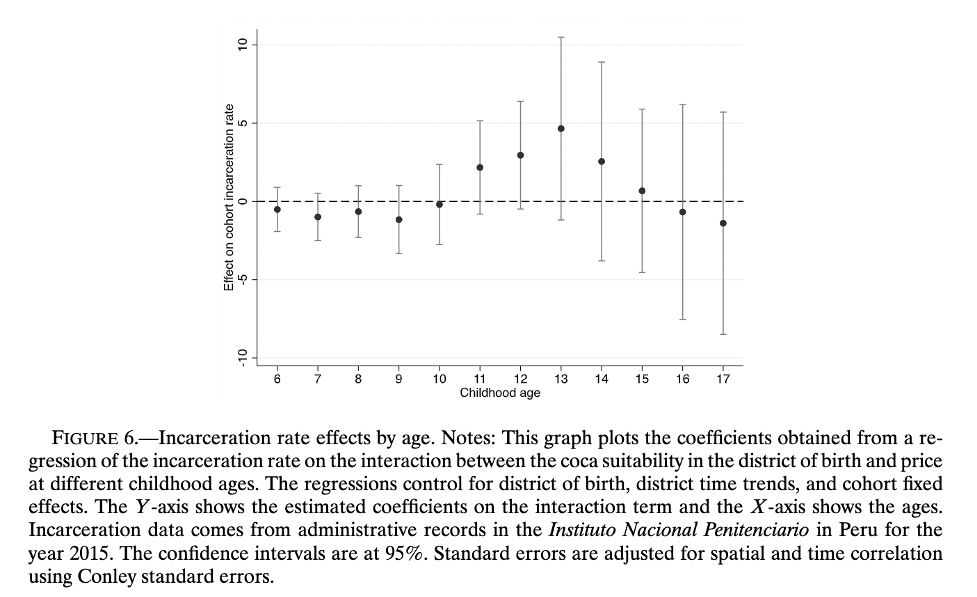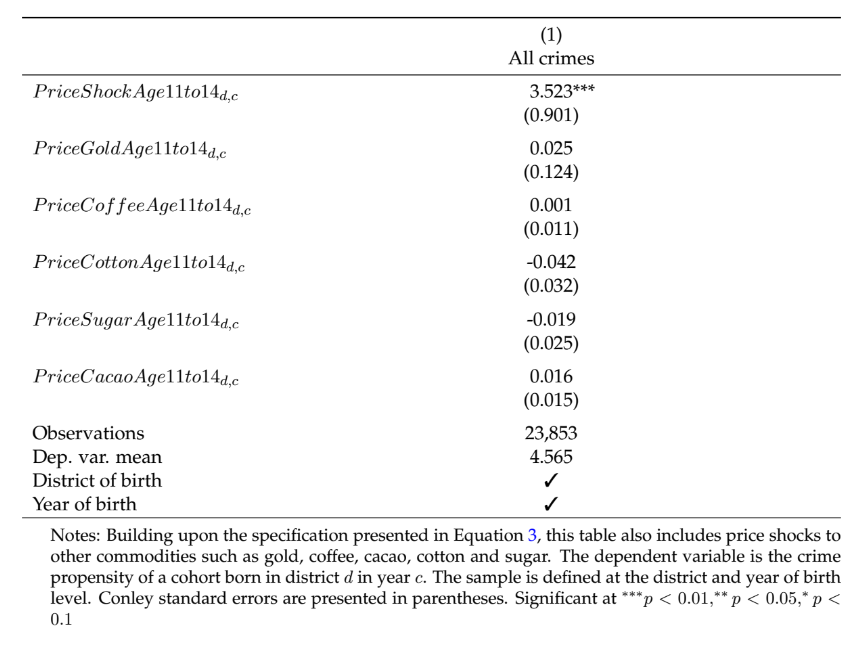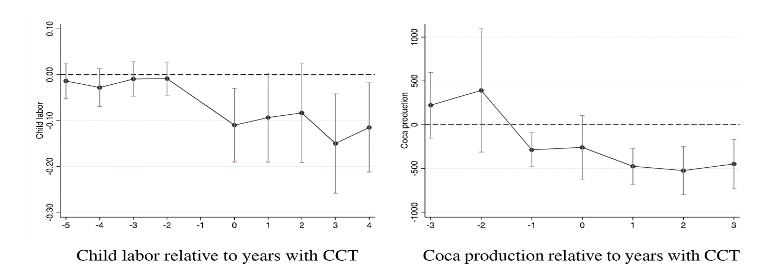Summary
Can childhood exposure to illegal labor markets lead to a life of crime? A recent study examines child labor in coca farming in Peru. When the price of coca is high, and hence the return to illegal activities in coca-suitable areas is also relatively high, some parents increase the use of child labor for coca farming. Children farming coca with illegal destinations are about 30% more likely to be incarcerated as adults for violent and drug-related crimes than unaffected counterparts. Quite strikingly, no such effect is found for children working in places where the coca produced goes primarily to the legal sector. The results suggest that some children acquire “criminal capital” by working in an illegal industry, and this fosters criminal careers in later life.
Economic shocks, such as changes in coca prices or income, can influence child labor through two main channels. Firstly, what economists call an “income effect” occurs when parents’ increased income enables them to withdraw their children from labor, since the additional income is no longer necessary. Secondly, higher coca prices may motivate parents to exploit child labor, to capitalize on the economic advantages of increased production. Notably, in rural Peru, it appears that the second effect tends to outweigh the first. Children exposed to significant coca price hikes, especially between the ages of 11 and 14 when crucial schooling decisions are made, may be up to 30% more likely to become child laborers. This can be attributed to several factors, such as children’s suitability for collecting coca leaves and the absence of legal prosecution in later stages of the production chain. As a result, those children also perform worse in school: high coca prices induce higher dropout rates, and increase the likelihood of failing a year and having a higher age than usual for each grade.
These findings point to the role of location-specific factors in shaping long-term outcomes for individuals. Specifically, children exposed to coca production are more prone to engage in criminal activities later and to face incarceration as adults. This underscores the key lesson of the research: the industry-specific skills developed in coca production during early adolescence can steer children towards a criminal path.
The findings also uncover an avenue for policy, which can weaken the link between booms in the cocaine industry and child labor. The rollout of a conditional cash transfer program, offering monetary support to parents if their children attended school regularly, lowered both coca production and child labor. This highlights the potential gains from implementing a similar conditional cash transfer targeted at children aged 11 to 14, living in areas where participation in the coca economy is high. By focusing on this critical age group, such a program could significantly reduce child labor rates and the overall production of coca. This offers notable advantages over more traditional anti-drug enforcement measures typically explored by researchers, since it is less likely to trigger additional violence or displace crime to other regions.
Main article
Illegal markets and associated crime are major concerns in developing countries and marginalized areas of rich countries, as exemplified by the impact of the drug trade from Peru and Colombia on the inner cities of the U.S. While criminal leaders such as Al Capone, Pablo Escobar, and El Chapo draw a lot of attention, illegal markets operate through a much larger set of individuals who support criminal organizations. Yet, we know far less about how these individuals enter crime. Are these decisions simply a matter of costs and benefits estimated on the spot, or are there specific and persistent factors that lead people to enter a life of crime from an early age?
What follows will outline how the coca economy might be one specific and persistent factor that leads people towards a criminal life path, and explain how a recent study establishes this for rural Peru. Children are put on a criminal life path when they invest in criminal human capital rather than formal schooling, when the returns to taking part in coca production are especially attractive. The study also explores the effectiveness of conditional cash transfers as a policy tool to offset the allure of high coca prices and mitigate the associated risks.
The short-term effects of cocaine production
To uncover the short-term effects of cocaine production on child labor and schooling, the study focuses on children aged 11 to 14 years. This age range is chosen for two reasons. Firstly, it corresponds to the transitional period from primary to secondary school, during which dropout rates increase significantly. This can be attributed to the combination of high coca prices, which can make coca production more attractive than schooling, and limited access to secondary schools in rural areas. Secondly, it is during early adolescence that children are especially likely to become more involved in the illicit aspects of coca production. They participate in activities such as transforming coca leaves into cocaine and even in product transportation. These factors suggest that changes in coca prices will be especially important for children within this age group.
Some children acquire “criminal capital” by working in an illegal industry
The table below shows the effects of coca prices on labor participation by age. As anticipated, there is a notably stronger impact for children aged 11 to 14 during periods of positive shocks in coca prices. Column 1 can be used to examine the effect of coca prices between the lowest point in 1997 and the peak in 2002. During this period, coca prices doubled. The estimates reveal that the price increase led to a significant, 12 percentage point rise in child labor among the 11 to 14 age group in districts suitable for coca production, compared to a roughly 7 percentage point increase in other age groups. The former implies a roughly 30% higher likelihood of being involved in child labor for the 11 to 14 age group.
Table 1. Effect of coca prices on labor participation by ages
Column 2 includes household “fixed effects” which account for differences between households that do not change over time, such as some family characteristics; this approach uses changing age-related exposure to variation in coca prices over time. The results are in line with those described earlier. Thus, it seems that the main results are not driven by time-invariant differences at the household level. This additional evidence supports the validity of the main results.
The industry-specific skills developed in coca production during early adolescence can steer children towards a criminal path
Moving on, the paper explores the effects of coca prices on schooling. The findings reveal that when coca prices rise during critical stages of education, dropout rates increase, and there is a higher likelihood of children failing their current grade. Additionally, these circumstances contribute to children being older for the grade they are currently enrolled in. This information is captured in column 2 of table 2.
Table 2. The effect of coca prices on schooling
The long-term effects of early participation in the illegal industry
So far, the results show that children facing higher coca prices during key years of schooling are more likely to engage in child work, at the expense of their performance at school. These children experience setbacks across various measures of educational achievement. This finding raises another significant question: how do increased child labor and educational difficulties affect long-term outcomes? In particular, the research examines the impact of coca shocks at different ages on later incarceration rates.
The results, shown in Figure 1 indicate that children in critical age ranges who live in areas where coca production is more prevalent, during periods of high coca prices, face an elevated risk of later incarceration. It is worth noting that variations in price or suitability experienced at earlier ages, or when individuals are already enrolled in secondary education (15 to 17 years old), see no significant effects on later incarceration rates.
Figure 1. Incarceration rate effects by age
The mechanism: criminal human capital
There are two main mechanisms that could be driving the effects on adult criminal activity: an increase in “criminal capital”, or a decrease in formal human capital, such as educational qualifications. On the one hand, it could be the case that illegal labor market opportunities increase criminal exposure during childhood, and these investments in industry-specific criminal capital increase the benefits from future involvement in the industry. This criminal capital may include skills in violence, as well as knowledge of how the industry works, obtained from interacting with individuals at various stages of cocaine production; or from social capital, such as contacts with buyers. On the other hand, the results could also be explained by a reduction in schooling during childhood. As children drop out of school, they may have fewer opportunities and face lower wages in the formal sector, increasing future involvement in crime.
Table 3. Coca prices during childhood and subsequent criminal behavior
To shed light on these mechanisms, Table 3 shows how coca influences every type of crime. There are positive, significant effects on drug trafficking and violent crimes, and no effects on other crimes. These results are consistent with the criminal capital channel. Children who work in this industry at an early age are more likely to be involved in the drug trade later on, leading to incarceration for industry-specific crimes such as drug trafficking and murder.
Panel (B) presents the results for women. Those women who were exposed to high coca prices in coca-suitable districts are more likely to be incarcerated for drug trafficking, but not other offenses. This is consistent with the qualitative evidence that women are primarily involved in the non-violent parts of the drug trade. Moreover, the absence of an effect for other crimes may indicate that the correlation between childhood exposure and drug trafficking crimes is unlikely to be spuriously driven by omitted factors, unless such factors affect differentially drug trafficking crimes more than other crimes.
Children who work in this industry at an early age are more likely to be involved in the drug trade later on
Next, to understand further whether the effects are driven by an increase in criminal capital or just by a reduction in formal human capital, the next step exploits price shocks to other commodities that also increase child labor in similar magnitudes at the relevant ages 11-14, but in legal sectors. The results in Panel (C) in Table 3 first examine the differential effect for districts where most coca production goes to the legal industry. Individuals from these districts are less likely to be involved in drug-related crimes in adulthood. The entire effect on drug-related crimes is due to areas with illegal coca, not areas with legally grown coca.
To explore this issue further, Table 4 examines how price shocks to legal commodities such as coffee, cacao, sugar, cotton, and gold affect criminal behavior. It is noteworthy that child labor is sensitive to price changes in some of these commodities, but there is no evidence to suggest that early participation in these sectors affects later incarceration rates. Child labor alone seems insufficient to explain why individuals are drawn towards criminal paths. It is specifically child labor in illegal industries that appears to have this effect.
Table 4. The effects of price shocks to other commodities on future criminality
Can conditional cash transfers mitigate high coca prices?
The results presented so far invite us to ask: What policy tool could counteract the short- and long-term effects of the allure of the cocaine economy? Previous literature has focused on drug enforcement measures, but these have been shown to trigger undesirable side effects. They can increase violence or simply shift the problem to different areas (Abadie et al. 2015; Dell, 2015; Castillo et al. 2018). For this reason, the research summarized here studies the effects of an alternative policy: conditional cash transfers. It examines whether implementing a conditional cash transfer program, where parents received financial assistance contingent upon their children’s regular school attendance, led to reductions in coca production and child labor. Figure 2 displays the results.
Figure 2. The effects of CCTs when coca prices are high
The figures show that, upon receiving the transfer, both child labor and coca production drop significantly. What do these findings imply? On the one hand, they help to disentangle the mechanisms driving the previous estimates. If the long-term effects found there were driven by factors other than child labor in the criminal sector, increasing the returns to schooling via conditional cash transfers would not mitigate the effects.
Children who work in this industry at an early age are more likely to be involved in the drug trade later on
On the other hand, these results shed light on the role of policy. Policymakers can potentially address some of the problems related to criminality by improving incentives to invest in schooling. Not only does this lower coca production in the short run, these policies could also reduce future criminality by putting individuals on a non-criminal path.
Moreover, if we are willing to extrapolate what we have learned from shocks to coca prices, there are a few lessons for future policies. First, if conditional cash transfers work through the same incentive channels as price shocks, their effects are mainly due to changing relative incentives in the household rather than changing income. That is, conditional transfers work because they increase the “opportunity cost” of having children working in the field, by increasing the present monetary value of investing in education. Second, future policies that aim to decrease child labor or drug-related criminality should study which sections of the population would be most affected. In the Peruvian case examined here, the best policy design might include not only direct incentives for education, as previously noted, but should also target children ages 11-14 specifically, in order to maximize impact per dollar.
This article summarizes “Making a Narco: Childhood exposure to illegal labor markets and criminal life paths” by Maria Micaela Sviatschi, published in Econometrica in 2022.
Maria Micaela Sviatschi is at Princeton.












